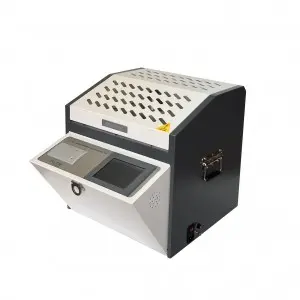In the realm of electrical systems and equipment, ensuring the integrity and reliability of insulating oils is crucial for maintaining optimal performance. Tan delta testing, also known as dissipation factor testing, is a powerful method used to evaluate the quality and condition of insulating oils. In this blog post, we will explore the significance of tan delta testing and delve into the capabilities of tan delta test kits for oil analysis, enabling thorough and accurate assessment of insulating oils.

Tan delta testing is a diagnostic technique that measures the dielectric dissipation factor of insulating oils. The dielectric dissipation factor, commonly referred to as tan delta or simply δ, is a measure of the power loss in the insulating material when subjected to an alternating electric field. It provides valuable insights into the condition of the insulating oil, highlighting potential issues such as contamination, degradation, or moisture content.
Tan delta testing is typically performed using a tan delta test kit, which consists of specialized equipment and software for accurate and reliable analysis. The test kit includes a precision measurement system, electrodes, and software for data acquisition and analysis. The measurement system generates an alternating electric field and measures the current and voltage response of the insulating oil sample, allowing for the calculation of the tan delta value.
The tan delta value obtained from the test provides information about the insulation quality of the oil. A low tan delta value indicates a well-maintained and high-quality insulating oil, while a high tan delta value suggests potential issues such as contamination or degradation. By monitoring the tan delta value over time, operators can assess the condition of the insulating oil and take appropriate maintenance actions if necessary.
Oil tan delta analysis offers numerous benefits for electrical systems and equipment. Firstly, it provides a non-destructive and non-intrusive method of assessing the condition of the insulating oil, without the need for extensive disassembly or sampling. This saves time and cost while enabling regular monitoring and preventive maintenance.
Secondly, tan delta testing allows for early detection of potential issues in the insulating oil, enabling proactive measures to be taken before they escalate into major problems. By identifying contaminants, moisture, or degradation in the oil, operators can implement measures such as filtration, purification, or replacement to ensure the optimal performance of their electrical equipment.
Furthermore, tan delta testing is highly sensitive and can detect even small changes in the insulation quality of the oil. This makes it a valuable tool for trending analysis, where the tan delta value is monitored over time to identify any gradual degradation or changes in the insulating oil’s condition. Trending analysis helps operators make informed decisions regarding maintenance intervals, replacement schedules, and overall system reliability.
It is important to note that tan delta testing should be performed by trained professionals using calibrated equipment and following established procedures. The accuracy and reliability of the test results depend on the proper setup and execution of the test, as well as the interpretation of the data. Consulting with experts in the field or partnering with reputable service providers can ensure accurate and meaningful tan delta analysis.